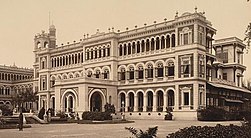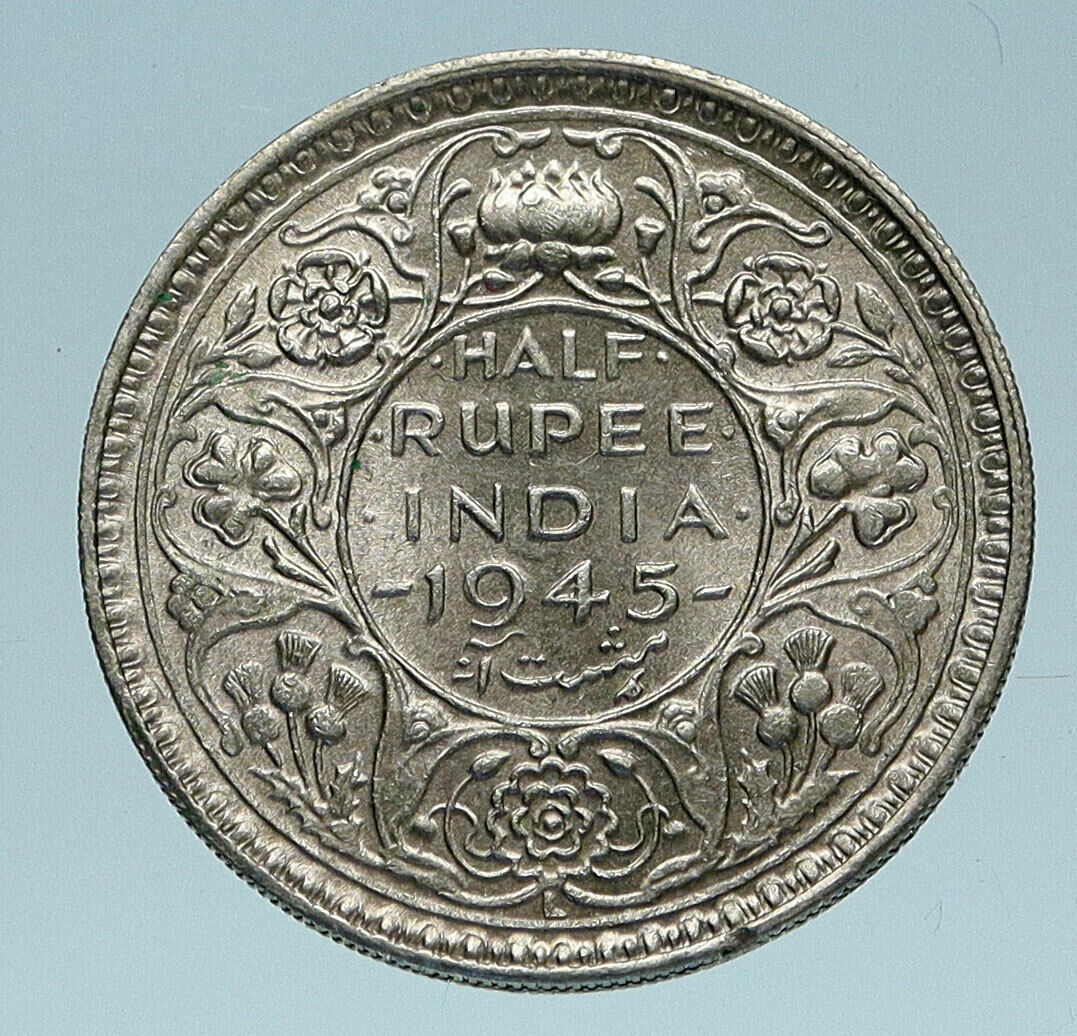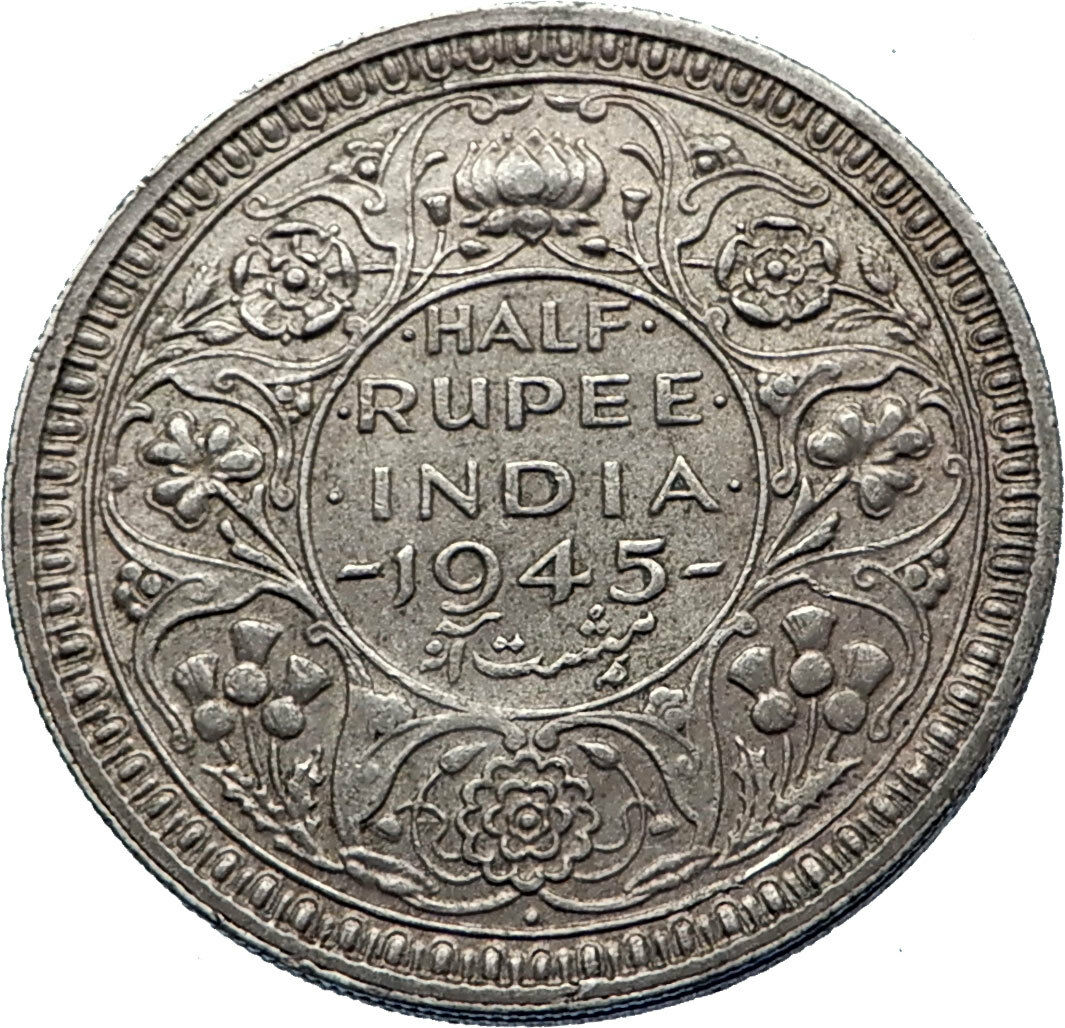|
India – Princely States – Jaora
Muhammad Ismail Khan – 1885-1895 AD
1893 (VS 1940-1950) Copper 2 Paisa 31mm (12.60 grams)
Reference: KM# 12
सरकार जावरा ١٣١٠ १९५०, Flag and Urdu script inside circle, with Hindi script.
H.H.THE NAWAB OF JAORA 1893, Inscription within circle.
You are bidding on the exact item pictured, provided with a Certificate of Authenticity and Lifetime Guarantee of Authenticity.
  Baroda State was a state in present-day Gujarat, ruled by the Gaekwad dynasty of the Maratha Confederacy from its formation in 1721 until its accession to the newly formed Dominion of India in 1949. With the city of Baroda (Vadodara) as its capital, during the British Raj its relations with the British were managed by the Baroda Residency. The revenue of the state in 1901 was Rs. 13,661,000. Baroda formally acceded to the Union of India, on 1 May 1949, prior to which an interim government was formed in the state. Baroda State was a state in present-day Gujarat, ruled by the Gaekwad dynasty of the Maratha Confederacy from its formation in 1721 until its accession to the newly formed Dominion of India in 1949. With the city of Baroda (Vadodara) as its capital, during the British Raj its relations with the British were managed by the Baroda Residency. The revenue of the state in 1901 was Rs. 13,661,000. Baroda formally acceded to the Union of India, on 1 May 1949, prior to which an interim government was formed in the state.
 Baroda derives its native name Vadodara from the Sanskrit word vatodara, meaning ‘in the heart of the Banyan (Vata) tree. It also has another name, Virakshetra or Virawati (land of warriors), mentioned alongside Vadodara by the 17th century Gujarati poet Premanand Bhatt, native to the city. Its name has been mentioned as Brodera by early English travellers and merchants, from which its later name Baroda was derived. Geographically it comprised several disjointed tracts of land, measuring over 1000 square miles, spread across the present Gujarat state; these were subdivided into four prant (states), namely Kadi, Baroda, Navsari and Amreli, which included coastal portions of the state, in the Okhamadal region near Dwarka and Kodinar near Diu. Baroda derives its native name Vadodara from the Sanskrit word vatodara, meaning ‘in the heart of the Banyan (Vata) tree. It also has another name, Virakshetra or Virawati (land of warriors), mentioned alongside Vadodara by the 17th century Gujarati poet Premanand Bhatt, native to the city. Its name has been mentioned as Brodera by early English travellers and merchants, from which its later name Baroda was derived. Geographically it comprised several disjointed tracts of land, measuring over 1000 square miles, spread across the present Gujarat state; these were subdivided into four prant (states), namely Kadi, Baroda, Navsari and Amreli, which included coastal portions of the state, in the Okhamadal region near Dwarka and Kodinar near Diu.
 The Marathas first attacked Gujarat in 1705. By 1712, a Maratha leader Khande Rao Dabhade grew powerful in the region and when he returned to Satara in 1716, he was made the senapati (commander in chief). Thereafter during the “Battle of Balapur” in 1721, one of his officers, Damaji Gaekwad was awarded the title Shamsher Bahadur or Distinguished Swordsman. Damaji died in 1721 and was succeeded by his nephew Pilajirao. The Marathas first attacked Gujarat in 1705. By 1712, a Maratha leader Khande Rao Dabhade grew powerful in the region and when he returned to Satara in 1716, he was made the senapati (commander in chief). Thereafter during the “Battle of Balapur” in 1721, one of his officers, Damaji Gaekwad was awarded the title Shamsher Bahadur or Distinguished Swordsman. Damaji died in 1721 and was succeeded by his nephew Pilajirao.
Thus the Baroda State was founded in 1721, when the Maratha general Pilaji Gaekwad conquered Songadh from the Mughals. Prior to this Pilajirao was appointed as general to collect revenues from Gujarat by the Peshwa, the effective ruler of the Maratha Empire, who had taken over the region north and south of Surat from the Mughals to established the Sarkar of Surat. Songadh remained the headquarters of the “House of Gaekwad” until 1866. After the Second Anglo-Maratha War (1803–1805), the East India Company wrested control of much of Gujarat from the Marathas. However the Gaekwads of Baroda (Vadodara), made a separate peace with the British, entering into a subsidiary alliance which acknowledged British suzerainty and control of the state’s external affairs in return for retaining internal autonomy.
Princely state
Following the death of Sir Khanderao Gaekwad (1828–1870), the popular Maharaja of Baroda, in 1870, it was expected that his brother, Malharrao (1831–1882), would succeed him. However, Malharrao had already proven himself to be of the vilest character and had been imprisoned earlier for conspiring to assassinate Khanderao. As Khanderao’s widow, Maharani Jamnabai (1853–1898) was already pregnant with a posthumous child, the succession was delayed until the gender of the child could be proven. The child proved to be a daughter, and so upon her birth on 5 July 1871, Malharrao ascended the throne.
Malharrao spent money liberally, nearly emptying the Baroda coffers (he commissioned a pair of solid gold cannon and a carpet of pearls, among other expenses) and soon reports reached the Resident of Malharrao’s gross tyranny and cruelty. Malharrao further attempted to cover up his deeds by poisoning the Resident, Colonel R. Phayre C.B. with a compound of arsenic. By order of the Secretary of State for India, Lord Salisbury, Malharrao was deposed on 10 April 1875 and exiled to Madras, where he died in obscurity in 1882. With the throne of Baroda now vacant, Maharani Jamnabai called on the heads of the extended branches of the dynasty to come to Baroda and present themselves and their sons in order to decide upon a successor.
Kashirao and his three sons, Anandrao (1857–1917), Gopalrao (1863–1938) and Sampatrao (1865–1934) walked to Baroda from Kavlana-a distance of some 600 kilometers-to present themselves to Jamnabai.
Eventually Gopalrao was selected by the British Government as successor and was accordingly adopted by Maharani Jamnabai, on 27 May 1875. He was also given a new name, Sayajirao. On 16 June 1875, he ascended the throne as Sayajirao Gaekwad III, but being a minor, reigned under a Council of Regency until he came of age and was invested with full ruling powers on 28 December 1881. founding numerous institutions. Various important state institutions were founded in the early 20th century, including the Bank of Baroda on 20 July 1908. In 1908, Sayajirao also founded the Baroda Legislative Assembly (also known as the Baroda Dhara Sabha).
By the beginning of the 20th century, the relations of the British with the four largest princely states—Hyderabad, Mysore, Jammu and Kashmir, and Baroda were managed by a British Resident under the direct authority the Governor-General of India. In 1911, Baroda State spanned 3,239 km2 (1,251 sq mi), and the population was 2,032,798 persons as per the 1911 census of India. The state was very wealthy. The Pittsburgh Press reported in 1927 that the diamond necklace, which contained the Star of the South diamond, was a part of a royal collection worth $10,000,000 at the time, housed in the Nazarbaug Palace (built 1721) in Baroda city; another important part of the collection was a cloth embroidered with precious stones and seed pearls, made to cover the tomb of Mohammed.
Dr. B.R.Ambedkar writes about his experience with untouchability in Baroda in the second chapter of his autobiographical book, Waiting for a Visa.
In 1937 the princely states of the Baroda Residency were merged with those of the agencies adjacent to the northern part of the Bombay Presidency —Rewa Kantha Agency, Surat Agency, Nasik Agency, Kaira Agency and Thana Agency— in order to form the Baroda and Gujarat States Agency. A few years before independence the process of the ‘Attachment Scheme’ began in order to integrate the smallest princely states, estates and thanas. Baroda State was one of the main beneficiaries of this measure by being able to add about 15,000 km2 and half a million inhabitants to the state. The merged states were Pethapur on 1 February 1940, the Katosan Thana, with Deloli, Kalsapura, Maguna, Memadpura, Rampura, Ranipura, Tejpura, Varsora, the Palaj Taluka and both Ijpura States between June and July 1940. These were followed on 10 July 1943 by the states of Ambliara, Ghorasar, Ilol, Katosan, Khadal, Patdi, Punadra, Ranasan, Wasoda and Wao Also many small Talukas of the region were merged. On 24 July 1943 Sachodar State and a few small places that had no own jurisdiction were annexed. By December of the same year the small states of Bajana, Bhilka, Malpur, Mansa and Vadia followed suit. Finally on 5 November 1944 the Baroda and Gujarat States Agency was merged with the Western India States Agency (WISA) to form the larger Baroda, Western India and Gujarat States Agency.
After the independence of India, which initially did not include Baroda or many other princely states, an interim government under Prime Minister Dr. Jivraj Narayan Mehta, son-in-law of Manubhai Mehta, then Dewan of Baroda state, was inaugurated in the State, on 4 September 1948, by the then Maharaja at a special Durbar in the Laxmi Vilas Palace, Baroda. Finally on 1 May 1949, Baroda State, the third largest state at the time of British India, formally acceded to the Dominion of India, Initially, Baroda merged with the Bombay state, and then, on 1 May 1960, when the two new states of Gujarat and Maharashtra were formed, it became part of Gujarat, with Dr. Jivraj Narayan Mehta becoming the first Chief Minister of Gujarat.
Colonial India is the part of the Indian subcontinent which was under the control of European colonial powers, through trade and conquest. The first European power to arrive in India was the Macedonian army of Alexander the Great in 327-326 BC. The satraps he established in the north west of the subcontinent quickly crumbled after he left. Later, trade was carried between Indian states and the Roman Empire by Roman sailors who reached India via the Red Sea and Arabian Sea , but the Romans never sought trading settlements or territory in India. The spice trade between India and Europe was one of the main types of trade in the world economy and was the main catalyst for the period of European exploration . The search for the wealth and prosperity of India led to the accidental “discovery” of the Americas by Christopher Columbus in 1492. Only a few years later, near the end of the 15th century, Portuguese sailor Vasco da Gama became the first European to re-establish direct trade links with India since Roman times by being the first to arrive by circumnavigating Africa (1497-1499). Having arrived in Calicut , which by then was one of the major trading ports of the eastern world, he obtained permission to trade in the city from Saamoothiri Rajah . Trading rivalries brought other European powers to India. The Netherlands , England , France, and Denmark established trading posts in India in the early 17th century. As the Mughal Empire disintegrated in the early 18th century and then the Maratha Empire became weakened after the third battle of Panipat , the relatively weak and unstable Indian states which emerged were increasingly open to manipulation by the Europeans through dependent “friendly” Indian rulers. In the later 18th century Britain and France struggled for dominance through proxy Indian rulers and also by direct military intervention. The defeat of the redoubtable Indian ruler Tipu Sultan in 1799 marginalised French influence. This was followed by a rapid expansion of British power through the greater part of the subcontinent in the early 19th century. By the middle of the century, the British had already gained direct or indirect control over almost all of India. British India contained the most populous and valuable provinces of the British Empire and thus became known as “the jewel in the British crown”.
|






 Baroda State was a state in present-day Gujarat, ruled by the Gaekwad dynasty of the Maratha Confederacy from its formation in 1721 until its accession to the newly formed Dominion of India in 1949. With the city of Baroda (Vadodara) as its capital, during the British Raj its relations with the British were managed by the Baroda Residency. The revenue of the state in 1901 was Rs. 13,661,000. Baroda formally acceded to the Union of India, on 1 May 1949, prior to which an interim government was formed in the state.
Baroda State was a state in present-day Gujarat, ruled by the Gaekwad dynasty of the Maratha Confederacy from its formation in 1721 until its accession to the newly formed Dominion of India in 1949. With the city of Baroda (Vadodara) as its capital, during the British Raj its relations with the British were managed by the Baroda Residency. The revenue of the state in 1901 was Rs. 13,661,000. Baroda formally acceded to the Union of India, on 1 May 1949, prior to which an interim government was formed in the state. Baroda derives its native name Vadodara from the Sanskrit word vatodara, meaning ‘in the heart of the Banyan (Vata) tree. It also has another name, Virakshetra or Virawati (land of warriors), mentioned alongside Vadodara by the 17th century Gujarati poet Premanand Bhatt, native to the city. Its name has been mentioned as Brodera by early English travellers and merchants, from which its later name Baroda was derived. Geographically it comprised several disjointed tracts of land, measuring over 1000 square miles, spread across the present Gujarat state; these were subdivided into four prant (states), namely Kadi, Baroda, Navsari and Amreli, which included coastal portions of the state, in the Okhamadal region near Dwarka and Kodinar near Diu.
Baroda derives its native name Vadodara from the Sanskrit word vatodara, meaning ‘in the heart of the Banyan (Vata) tree. It also has another name, Virakshetra or Virawati (land of warriors), mentioned alongside Vadodara by the 17th century Gujarati poet Premanand Bhatt, native to the city. Its name has been mentioned as Brodera by early English travellers and merchants, from which its later name Baroda was derived. Geographically it comprised several disjointed tracts of land, measuring over 1000 square miles, spread across the present Gujarat state; these were subdivided into four prant (states), namely Kadi, Baroda, Navsari and Amreli, which included coastal portions of the state, in the Okhamadal region near Dwarka and Kodinar near Diu. The Marathas first attacked Gujarat in 1705. By 1712, a Maratha leader Khande Rao Dabhade grew powerful in the region and when he returned to Satara in 1716, he was made the senapati (commander in chief). Thereafter during the “Battle of Balapur” in 1721, one of his officers, Damaji Gaekwad was awarded the title Shamsher Bahadur or Distinguished Swordsman. Damaji died in 1721 and was succeeded by his nephew Pilajirao.
The Marathas first attacked Gujarat in 1705. By 1712, a Maratha leader Khande Rao Dabhade grew powerful in the region and when he returned to Satara in 1716, he was made the senapati (commander in chief). Thereafter during the “Battle of Balapur” in 1721, one of his officers, Damaji Gaekwad was awarded the title Shamsher Bahadur or Distinguished Swordsman. Damaji died in 1721 and was succeeded by his nephew Pilajirao.






